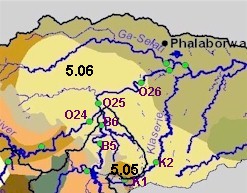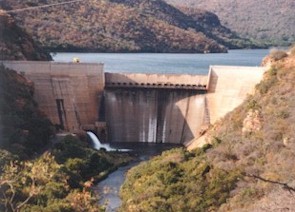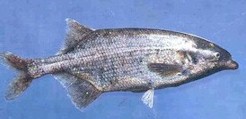|
Ecoregion and River Characteristics
These ecoregions are lowveld regions, with a mean altitude of 300-600 m amsl, and a warm, dry climate (22°C on average, with 400-800 mm precipitation per year). Lowveld bushveld is the major vegetation type.
The Blyde River meanders through the Drakensberg and enters the Lowveld before its confluence with the Olifants River. The riverbed is characterized by an abundance of big rocks, stones and pebbles. The riparian zone alternates between narrow zones close to the stream and broad zones with sandbanks and floodplains. The floodplains are elevated in relation to the riverbed.
|
|
Present Ecological State
Ecoregion 5.05
The ecological state of the Klaserie River is
good
in terms of in-stream and riparian habitats, and in terms of fish populations. Invertebrates and riparian vegetation reflect a
fair
state.
|
|

|
Ecoregion 5.06
Upstream of the Phalaborwa Barrage, the Olifants River is in a
fair
to
poor
state in terms of in-stream and riparian habiatat, while the biological indicators in general reflect a
fair
state.
The Blyde River is in an overall
good
state and in parts the fish population occasionally reflects
natural
health conditions.
The Klaserie River is in an overall
good
state, with fish and invertebrates occasionally reflecting
natural
health.
|
|
Drivers of Ecological Change (Land-use activities)
Ecoregion 5.05
This area is mainly an agricultural (citrus farming) and conservation area, with forestry in the upper-most part. Plantations close to the river, cause in-stream sedimentation.
Ecoregion 5.06
The health of the Olifants River improves downstream of the confluence with the Blyde River, as the water coming in from the Blyde River is of better quality than that in the Olifants River.
|
|
Timeshare developments and other houses have been built in the riparian zone, requiring clearing of vegetation and increased risk of erosion. Mango and citrus orchards, which also allow little ground cover, flourish.
Ecologically insensitive releases for irrigation are a major problem to habitats and communities downstream of the Blyderivierspoort Dam. Very wide stretches of exceptionally well-developed riparian vegetation occur.
|

|

|
The Bulldog fish (Marcusenius macrolepidotus) are abundant in the lower Blyde River. This species is particularly sensitive to high salinity as it uses electromagnetic pulses to find food and mates, and thus its presence is indicative of good water and habitat quality.
|
|
Desired Ecological State and Response by Resource Managers
The Blyde River in this area forms part of the so-called "Kruger to Canyon" biosphere reserve initiative. This initiative will focus management towards conservation for a
natural
river state, as high water quality in this region is critical for maintaining water quality downstream in the Kruger National Park and other conservation areas.
The management goal for the Klaserie River is to maintain the river in a
good
ecological state.
Alien species like the wattle should be controlled. In order to control Xanthium strumarium, programmes will have to include the bigger catchment area since the seeds are spread by water.
The desired state for the Olifants River is
fair
.
|
|





|
|























